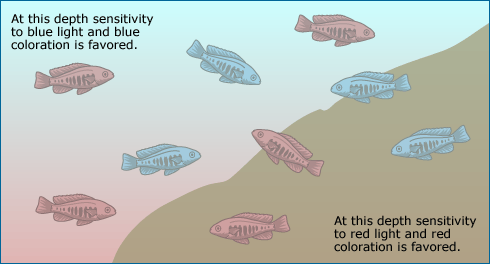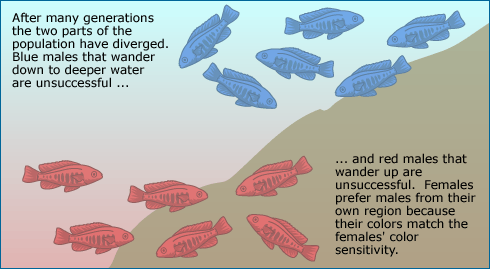
If you’ve been following our monthly updates, you already know that 2009 is the Year of Science. To celebrate this month’s theme, physics and technology, Evo in the News reports on a recent story that highlights how an understanding of basic physics can illuminate evolution going on today — in particular how the physics of light influences sexual selection, speciation, and the collapse of biodiversity with human-caused pollution.
Holding a prism up to a bright window demonstrates a basic principle of optics — that the plain white light radiating from our sun is actually made up of a rainbow of colors. Through air, these colors of light all travel in about the same way, but in water, different colors travel differently. Water molecules tend to absorb reddish light, leaving the blue light to travel towards the depths of large bodies of water. Because of this, deep ocean waters look blue. However, everything changes when the water is clouded by particles. Just picture a silt-clogged river or lake. Such sediment particles are particularly good at absorbing bluish light — the opposite of water molecules. So when the sun shines on cloudy waters, blue light is present near the surface, but just a few meters down, most of the blue light will have been absorbed and mainly reddish light will penetrate.
Where's the evolution?
The physics of light affects not just how blue water looks to us, but how the animals living in the world’s oceans, lakes, and rivers are able to find food and each other — and this, in turn, can impact their evolution. Natural selection favors traits that perform well in local environmental conditions. Many fish species, for example, have evolved vision that is specifically tuned to see well in the sort of light available where they live. But even beyond simple adaptation, the physics of light can lead to speciation. In fact, biologists recently demonstrated that the light penetrating to different depths of Africa’s Lake Victoria seems to have played a role in promoting a massive evolutionary radiation. More than 500 species of often brightly colored cichlid fish have evolved there in just a few hundred thousand years!
To understand how the physics of light can promote speciation, picture a lake with slightly cloudy water. Near the surface, blue light dominates the visual environment, but in deeper waters, red light does. A fish population lives along the lake’s shore where it slopes from very shallow water to deeper water — so some of the fish spend more of their time in blue light and some spend more of their time in red light. Like all populations, the fish have genetic variation — that is, individual fish have different gene versions from one another — and some of this variation affects the fishes’ ability to see different colors. Some fish have genes that enable them to see blue light better, while other fish have a red light advantage. Because of the differential penetration of light into the lake, fish with gene versions sensitizing them to blue light have an advantage in shallower waters because they can better find food and spot predators there, while fish tuned to red light have an advantage in deeper waters. So in different parts of the fishes’ habitat, different color-sensitivity genes are favored by natural selection. Over many generations, if the fish don’t move too much within their range, blue sensitivity will evolve to be more common among fish living near the surface and red sensitivity will become more common among fish living further down the slope.
By itself, natural selection acting on light sensitivity can cause something of a rift in the population, but when sexual selection is considered as well, the divergence is amplified. To see how, add the male fish to the equation. They have some variation in color. Some males have genes for blue coloration, some have genes for red coloration. This matters because female fish are choosy about their mates and tend to pick brightly colored males to father their offspring. In this scenario, blue males living in deep waters would have trouble finding mates for two reasons: (1) there is little blue light around, so they look duller than red males, and (2) the females living in deep waters tend to be less sensitive to blue light than they are to red. On the other hand, red males living in deep water would be winners on both counts: their coloration makes the most of the available red light, and the females living at those depths tend to carry genes that make them extra-sensitive to red light. Bottom-dwelling blue fish face a long series of lonely nights, while bottom-dwelling red fish get all the girls. And of course, the opposite is true near the surface. Over many generations of sexual selection acting in this way, the two parts of the population may diverge. Though they live right next door to one another, the fish will evolve to prefer to mate with other fish that share their coloration, light-sensitivity, and habitat. Over time, the two sub-populations may even cease to mate with one another entirely and evolve enough differences to be considered separate species.
Although the scenario described above is a hypothetical one based on evolutionary theory, biologists have now discovered strong evidence that this process has actually occurred in the cichlid fish of Lake Victoria. They’ve observed, along with other lines of evidence, many neighboring species pairs in which the surface-dwellers tend to be blue and blue-light-sensitive, while the deeper fish tend to be red and red-light-sensitive. Biologists are particularly excited about this discovery because it may represent an unusual mode of speciation. The sort of speciation that is easiest to gather evidence about is allopatric speciation — speciation that occurs partly through geographic isolation of the emerging species. In contrast, these cichlid species may have evolved without any physical separation at all.
Unfortunately, the cichlids of Lake Victoria face an uncertain future. In the past few decades, many cichlid species have disappeared. Some of these may have been pushed to extinction by invasive species, but others seem to have simply collapsed into one another. Deforestation, agricultural run-off, and pollution have caused the lake’s water to become much murkier. This has made it more difficult for the fish to choose mates based on color and has caused some species that rely on visual signals for mate choices (like the fish described above) to interbreed — resulting in fewer distinct species of fish and fish with duller colors. The recent research into how optics has influenced cichlid evolution shines a light on the processes that contribute to Earth’s fabulous biodiversity, but also highlights how easily that diversity can be snuffed out.
News update, July 2011
Research on the colorful cichlids of Lake Victoria continues! Since we published our first Evo in the News story on this topic, scientists have been hunting for more evidence that might back up their hypothesis that the physics of light penetration in the lake has contributed to cichlid speciation through the action of sexual selection — and they have found it. Last year, European researchers reported on their studies of Pundmilia nyererei, a Lake Victoria cichlid species in which the females prefer to mate with redder males. They found that P. nyererei females from clear areas of the lake were choosier — strongly preferring brightly colored males — than females from cloudy waters in the lake, who were more likely to accept dull colored males as mates. This supports the idea that murky waters in the lake can affect the evolution of female mate preference — that when sediments cloud the lake’s waters, females evolve to be less choosy about color. As you might expect, male coloration seems to have evolved in concert with female preference. P. nyererei males from clear waters tend to be redder than males from murky waters.
These results highlight the threat to Lake Victoria’s cichlids. As the lake’s waters become increasingly muddied with pollution and sediments, we can expect it to shape the evolution of female mating preference — and if females become less choosy, this may mean that formerly distinct species begin to collapse into one. In fact, this is already happening in some areas. Where waters are particularly cloudy, P. nyererei females mate and hybridize with a closely related species (Pundamilia pundamilia) in which males are blue.
Primary literature:
- Boughman, J. W. (2002). How sensory drive can promote speciation. Trends in Ecology and Evolution 17(12):571-577. Read it »
- Genner, M. J., Seehausen, O., Lunt, D. H., Joyce, D. A., Shaw, P. W., Carvalho, G. R., and Turner, G. F. (2007). Age of cichlids: new dates for ancient lake fish radiations. Molecular Biology and Evolution 24(5):1269-1282.
- Maan, M. E., Seehausen, O., and Van Alphen, J. J. M. (2010). Female preferences and male coloration covary with water transparency in a Lake Victoria cichlid fish. Biological Journal of the Linnean Society. 99: 398-406. Read it »
- Seehausen, O., van Alphen, J. J. M., and Witte, F. (1997). Cichlid fish diversity threatened by eutrophication that curbs sexual selection. Science 277(5333):1808-1811. Read it »
- Seehausen, O., Terai, Y., Magalhaes, I. S., Carleton, K. L., Mrosso, H. D. J., Miyagi, R., van der Sluijs, I., Schneider, M. V., Maan, M. E., Tachida, H., Imai, H., and Okada, N. (2008). Speciation through sensory drive in cichlid fish. Nature 455:620-626. Read it »
News articles:
- A friendly summary of the cichlid discovery from the New York Times
- A more detailed article explaining the research from Science News
Understanding Evolution resources:
- A tutorial on natural selection
- A quick review of sexual selection
- A tutorial on speciation, including different modes of speciation
Background information from Understanding Global Change:
- Review the concept of natural selection. What trait is natural selection acting on in the cichlids described above?
- Review the concept of sexual selection. What trait is sexual selection acting on in the cichlids described above?
- In the cichlid species described above, do you think that natural selection and sexual selection reinforce one another, act in opposing directions, or neither? Explain your reasoning.
- Read this short description of research on evolution in guppies. In the guppies, do natural and sexual selection reinforce or oppose one another — or do they not have any relationship to one another? Explain your reasoning.
- Research and describe traits in other three other organisms (not mentioned in the article above) that have been affected by sexual selection.
- Teach about sexual selection and fitness: This comic strip for grades 6-12 follows the efforts of a male cricket as he tries to attract a mate, and in the process, debunks common myths about what it means to be evolutionarily "fit."
- Teach about divergence and speciation: In this version of the bird beak activity for grades 6-12, students learn about how variation, habitat differences, and natural selection, can lead to adaptation and divergence.
- Boughman, J. W. (2002). How sensory drive can promote speciation. Trends in Ecology and Evolution 17(12):571-577.
- Genner, M. J., Seehausen, O., Lunt, D. H., Joyce, D. A., Shaw, P. W., Carvalho, G. R., and Turner, G. F. (2007). Age of cichlids: new dates for ancient lake fish radiations. Molecular Biology and Evolution 24(5):1269-1282.
- Maan, M. E., Seehausen, O., and Van Alphen, J. J. M. (2010). Female preferences and male coloration covary with water transparency in a Lake Victoria cichlid fish. Biological Journal of the Linnean Society. 99: 398-406.
- Seehausen, O., van Alphen, J. J. M., and Witte, F. (1997). Cichlid fish diversity threatened by eutrophication that curbs sexual selection. Science 277(5333):1808-1811.
- Seehausen, O., Terai, Y., Magalhaes, I. S., Carleton, K. L., Mrosso, H. D. J., Miyagi, R., van der Sluijs, I., Schneider, M. V., Maan, M. E., Tachida, H., Imai, H., and Okada, N. (2008). Speciation through sensory drive in cichlid fish. Nature 455:620-626.


